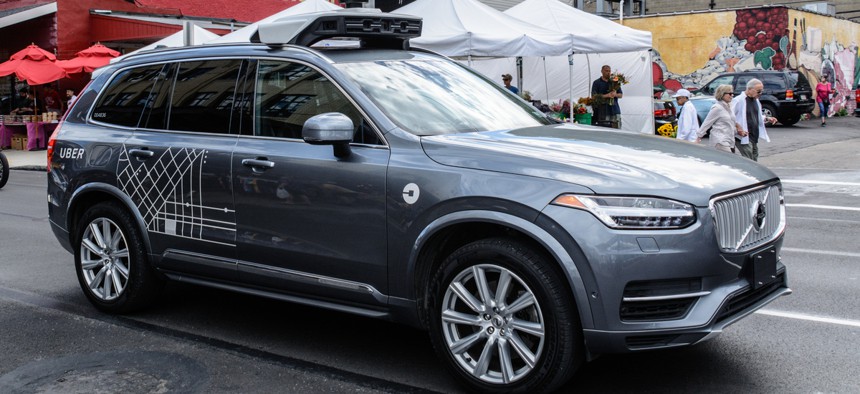Autonomous Vehicles Must Put People First

October 7, 2017, An Uber autonomous driving car, with back-up human driver aboard, navigates the Pittsburgh, Pennsylvania Strip District on a busy Saturday morning. Shutterstock
COMMENTARY | The mayor of Rochester Hills, Michigan, on why mayors are looking to shape the future of AVs.
During last week’s 86th Annual Meeting of the U.S. Conference of Mayors, I had the privilege of moderating a panel of mayors and industry experts on the topic of “Autonomous Vehicles and the American City.” The session was extremely well attended and conversations extended well beyond the time allotted—and for good reason. The evolution and adoption of AVs will change our cities and the way we live, forever.
USCM President and Columbia, South Carolina Mayor Steve Benjamin and I are leading a bi-partisan, two-year strategic platform for the Conference that focuses on Infrastructure, Innovation and Inclusion.
Indeed, no other topic may impact these Three I’s greater than the subject of AVs. We’re excited and energized by the potential of what they can do for our communities—and for people.
Change, Change, Change
Everything we know about how we get from one place to another is changing. Twenty years ago we pleaded: “Don't get in strangers' cars and don't meet people online.” Today, we literally summon strangers through the internet for rides in their cars.
Our residents aren’t sure what to think. Recent surveys suggest that most Americans (70 percent) believe autonomous vehicles will be quite common within 15 years. But 74 percent say they don’t expect to have one and 65 percent say they wouldn’t want to walk or ride a bicycle anywhere near one. Understandably, people are concerned about recent headlines and tragic outcomes. As the National Association of City Transportation Officials stated following March’s deadly crash in Arizona, “we cannot afford for companies’ race-to-market to become a race-to-the-bottom for safety.”
Cities Need to Lead the Conversation
In Rochester Hills, we’re especially thinking about how the growth of AVs will affect public funding, employment, data and land use.
When it comes to public funding, studies suggest that AVs will reduce revenue streams from traditional sources like parking, parking tickets, traffic citations, as well as prompt changes in use of mass transit, and reduction of sales tax collections on fuel, given AV electrification. We’re asking ourselves: Will distance-based road charges replace lost fuel tax revenue, as Bloomberg Philanthropies believes could happen?
And who will get the traffic citations in the event of an accident involving AVs?!
On the subject of employment, we’ve examined the USCM’s Metro Economies Report on Technology and the Future Labor Market (June 2018). It describes the speed at which technology is advancing and how the skills of our current workforce are not keeping pace. We expect job loss to stem from the growth of AVs, especially within the ranks of professional drivers for trucking, transit/taxi, delivery vehicles, and postal service delivery. On the flip side, job growth may come from the conversion of parking structures to other uses and jobs generated through the IT needed for the potentially massive AV roll out.
When it comes to data, we need to know who will own the enormous data sets that come from AVs. Louisville’s partnership with Waze demonstrates how real-time data collection allows the city to monitor and analyze traffic flow and assist with operations. It’s an excellent illustration of how data from vehicles are being collected, evaluated and deployed for the public good.
Finally, in Rochester Hills we’re closely monitoring the adoption of shared AVs versus private AVs because it will affect land use and development. If the public leans toward the use of shared vehicles, it could sharply reduce demand for development beyond the reach of shared service areas. But greater acceptance of private vehicles may instead lead to significant new housing and commercial development beyond current growth limits, as Bloomberg suggests.
We’re Energized by the Potential
Everyone in my community is excited about the potential for autonomous vehicles.
In addition to providing mobility for non-drivers, older citizens, and the mentally and physically disabled, AVs will improve traffic safety. Currently, 94 percent of U.S. vehicular crashes involve human error and over 35,000 U.S. motorists lose their lives each year in vehicle crashes, according to the National Highway Traffic Safety Administration. Self-driving technology companies, like Waymo, are on a path to “building the world’s most experienced driver,” leading to fewer accidents and fatalities, smoother traffic flow and the ability to be productive during a commute. In terms of sustainability, AVs will accelerate the shift to clean energy through vehicle electrification, and as Bloomberg suggests, there will be benefits from vehicles becoming smaller and lighter, right-sizing vehicles for trips and an increase in ride-sharing.
Through it all, as we navigate, create and lead change, we must keep people at the center of this movement. Not streets, not AV technology firms, not auto companies, but people.
My personal thanks to panelists Mayor John Giles from Mesa, Arizona, Mayor Sam Liccardo from San Jose, California, Simone Brody, executive director of What Works Cities and Ellie Casson, head of local policy at Waymo for a robust, informative and fun discussion during the USCM Conference.
Bryan K. Barnett is the mayor of Rochester Hills, Michigan, and the first vice president of the U.S. Conference of Mayors.

NEXT STORY: Sacramento drives digital license plate test





